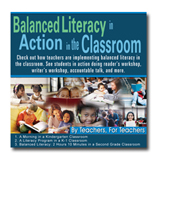| Balanced Literacy |

Learn how to do balanced literacy in the classroom with three experienced teachers. You'll spend “the morning” in three different elementary schools experiencing firsthand how to incorporate such balanced literacy elements in your classroom as word work, independent work time, read aloud, reader's and writer's workshops, guided reading, shared reading, accountable talk, mini-lesson. See how these teachers match the needs of their students and reflect on their practice.
Balanced Literacy is implemented through the Reading and Writing Workshop Model. The teacher begins by modeling the reading/writing strategy that is the focus of the workshop. Subsequently, students are engaged in practicing the focal strategy in small groups or independently as the teacher monitors and provides guidance. Selected students share their work. Then, students read leveled texts independently or write independently for an extended period of time as the teacher circulates amongst them to observe, record observations and confer. At the culmination of the workshop session, selected students share their strategies and work with the class.
Balanced Literacy is an approach to reading instruction that incorporates both whole language and phonics. Many of the components of Balanced Literacy, including the Reader's Workshop and Writer's Workshop, will be explored.
Courses Available for Balanced Literacy
Introduction to Balanced Literacy 1: The Reader’s Workshop
Balanced Literacy is an approach whose goal is to develop lifelong readers and thinkers. It exposes students to the habits of good readers by interacting with many genres and styles of literature. Components of balanced literacy, including the reader’s and writer’s workshop models, will be explored. Creating effective mini-lessons, grouping students appropriately, and planning effective guided reading lessons will be an integral part of the course.
Introduction to Balanced Literacy 2: Assessing Readers
Participants will learn how to create a classroom environment that supports effective literacy instruction for all learners. Both formal and informal assessment instruments will be examined, including running records and the use of miscue analysis to interpret students’ use of the cueing system. Teachers will learn the importance of conducting meaningful conferences to drive instruction.
Balanced Literacy 3: The Writer’s Workshop
The Workshop Model, a model for both reading and writing, contains a three-part structure: the mini-lesson, independent/small group work, and a share session. In the writer’s workshop, time is devoted each day to the process of writing. Students learn how to write by writing. Although this sounds simplistic, the workshop model structures the lessons by providing numerous opportunities for students to see modeled writing, be guided with structured writing, and to apply their skills through independent writing. These stages of interactive writing promote literacy.
Balanced Literacy 4: Building a Community of Writers
Participants will learn how to create a classroom environment that is conducive to writing and supports effective writing instruction for all learners, including struggling writers and English Language Learners. The continuum of skills that good writers possess will be reviewed. As they experience the writing process, participants will create a piece of their own writing. This self-guided course is designed for you, as a writer, to have fun and learn to focus on the skills that you will transfer to your students.
